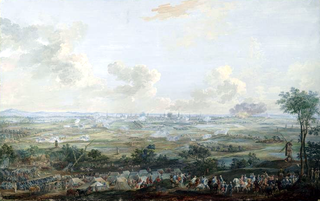
The War of the Austrian Succession was a European conflict fought between 1740 and 1748, primarily in Central Europe, the Austrian Netherlands, Italy, the Atlantic Ocean and Mediterranean Sea. Related conflicts include King George's War in North America, the War of Jenkins' Ear, the First Carnatic War, and the First and Second Silesian Wars.

The Battle of Fontenoy took place on 11 May 1745 during the War of the Austrian Succession, near Tournai, then part of the Austrian Netherlands, now in Belgium. A French army of 50,000 under Marshal Saxe defeated a Pragmatic Army of roughly the same size, led by the Duke of Cumberland.

The Battle of Fleurus, on 26 June 1794, was an engagement during the War of the First Coalition, between the army of the First French Republic, under General Jean-Baptiste Jourdan, and the Coalition army, commanded by Prince Josias of Coburg, in the most significant battle of the Flanders Campaign in the Low Countries during the French Revolutionary Wars. Both sides had forces in the area of around 80,000 men but the French were able to concentrate their troops and defeat the First Coalition. The Allied defeat led to the permanent loss of the Austrian Netherlands and to the destruction of the Dutch Republic. The battle marked a turning point for the French army, which remained ascendant for the rest of the War of the First Coalition.

James Wolfe was a British Army officer known for his training reforms and, as a major general, remembered chiefly for his victory in 1759 over the French at the Battle of the Plains of Abraham in Quebec.

Maurice, Count of Saxony was a notable soldier, officer and a famed military commander of the 18th century. The illegitimate son of Augustus II the Strong, King of Poland and Elector of Saxony, he initially served in the Army of the Holy Roman Empire, then the Imperial Army, before finally entering French service. De Saxe became a Marshal and even Marshal General of France. He is best known for his deeds in the War of the Austrian Succession and especially for his decisive victory at the Battle of Fontenoy.

The Diplomatic Revolution of 1756 was the reversal of longstanding alliances in Europe between the War of the Austrian Succession and the Seven Years' War. Austria went from an ally of Britain to an ally of France; the Dutch Republic, a long-standing British ally, became more anti-British and took a neutral stance while Prussia became an ally of Britain. The most influential diplomat involved was an Austrian statesman, Wenzel Anton von Kaunitz.

The Battle of Rocoux took place on 11 October 1746 during the War of the Austrian Succession, at Rocourt, near Liège in the Prince-Bishopric of Liège, now modern Belgium. It was fought between a French army under Marshal Saxe and a combined British, Dutch, German and Austrian force led by Charles of Lorraine, John Ligonier and Prince Waldeck.

The Battle of Lauffeld, variously known as Lafelt, Laffeld, Lawfeld, Lawfeldt, Maastricht, or Val, took place on 2 July 1747, between Tongeren in modern Belgium, and the Dutch city of Maastricht. Part of the War of the Austrian Succession, a French army of 80,000 under Marshal Saxe defeated a Pragmatic Army of 120,000, led by the Duke of Cumberland.

The Siege of Bergen op Zoom took place during the Austrian War of Succession, when a French army, under the command of Count Löwendal and the overall direction of Marshal Maurice de Saxe, laid siege and captured the strategic Dutch border fortress of Bergen op Zoom on the border of Brabant and Zeeland in 1747. The fortress was defended by Dutch, Austrians, British, Hanoverians and Hessians that supported the Pragmatic Sanction.

The Anglo-Austrian Alliance connected the Kingdom of Great Britain and the Habsburg monarchy during the first half of the 18th century. It was largely the work of the British Whig statesman Thomas Pelham-Holles, 1st Duke of Newcastle, who considered an alliance with Austria crucial to prevent the further expansion of French power.

The Low Countries theatre of the War of the First Coalition, also known as the Flanders campaign, was a series of campaigns in the Low Countries conducted from 20 April 1792 to 7 June 1795 during the first years of the War of the First Coalition. As the French Revolution radicalised, the revolutionary National Convention and its predecessors broke the Catholic Church's power (1790), abolished the monarchy (1792) and even executed the deposed king Louis XVI of France (1793), vying to spread the Revolution beyond the new French Republic's borders, by violent means if necessary. The First Coalition, an alliance of reactionary states representing the Ancien Régime in Central and Western Europe – Habsburg Austria, Prussia, Great Britain, the Dutch Republic, Hanover and Hesse-Kassel – mobilised military forces along all the French frontiers, threatening to invade Revolutionary France and violently restore the monarchy. The subsequent combat operations along the French borders with the Low Countries and Germany became the primary theatre of the War of the First Coalition until March 1796, when Napoleon took over French command on the Italian front.

The Fall of Ghent occurred on 15 July 1745 during the War of the Austrian Succession when a 5,000 strong French force under Ulrich Frédéric Woldemar, Comte de Lowendal surprised and captured the town of Ghent in the Austrian Netherlands. The Allied garrison offered little resistance.
The Battle of Melle was an encounter battle fought on 9 July 1745, during the War of the Austrian Succession, between forces of the Pragmatic Allies and the French. After their defeat at Fontenoy in May, the Duke of Cumberland, Allied commander in Flanders, was under pressure from the Austrians to defend Brussels. He also wanted to protect the key port of Ghent, a major supply depot threatened by the French advance into West Flanders.

The siege of Maastricht took place in April–May 1748 during the War of the Austrian Succession. A French force under the overall command of Maurice de Saxe besieged and captured the Dutch barrier fortress of Maastricht in the final few months of the campaign in the Low Countries. After a relatively long siege the garrison of Maastricht capitulated and marched out with the honours of war. Maastricht was returned along with France's conquests in the Austrian Netherlands according to the Treaty of Aix-la-Chapelle signed in 1748.

Wenzel Anton, Prince of Kaunitz-Rietberg was an Austrian and Czech diplomat and statesman in the Habsburg monarchy. A proponent of enlightened absolutism, he held the office of State Chancellor for about four decades and was responsible for the foreign policies during the reigns of Maria Theresa, Joseph II, and Leopold II. In 1764, he was elevated to the noble rank of a Prince of the Holy Roman Empire (Reichfürst).

The Battle of Courtrai saw a Republican French army under Jean-Charles Pichegru oppose Coalition forces commanded by François Sébastien Charles Joseph de Croix, Count of Clerfayt. The battle was fought as part of French efforts to defeat an Allied attempt to recapture Courtrai, which the French captured in the opening days of their 1794 offensive in the Low Countries. On 10 May, a French attempt to advance east toward Tournai was turned back by the Duke of York's troops in the Battle of Willems, but resulted in York himself retreating to Tournai once he realised he had underestimated the size of the French army. On the same day as Willems, Clerfayt attacked Courtrai from the north but made little progress. On 11 May, with York's retreat, French forces turned on Clerfayt at Courtrai after York's retreat and forced him to retreat to the north. As a result of the battle, the French Army of the North maintained their grip on Courtrai and Menin which it had won in late April. The fighting occurred during the War of the First Coalition near Kortrijk, Belgium, located about 85 kilometres (53 mi) west of Brussels.

The Pragmatic Army was an army which served during the War of the Austrian Succession. It was formed in 1743 by George II, who was both King of Great Britain and Elector of Hanover, and consisted of a mixture of British, Hanoverian, and Austrian troops. It was designed to uphold the Pragmatic Sanction in support of George's ally Maria Theresa of Austria and took its name from this.

The siege of Tournai was a two-month siege of the city and citadel of Tournai, then part of the Austrian Netherlands, in 1745 during the War of the Austrian Succession. The allied Pragmatic Army's attempt to relieve the siege resulted in the decisive French victory at the Battle of Fontenoy on 11 May. The largely Dutch garrison of the city subsequently surrendered to French forces on 22 May, while the garrison of the citadel surrendered on 19 June 1745. It was one of the longest sieges of the war.

The siege of Mons was an engagement from 7 June to 23 July 1746 during the War of the Austrian Succession. The town of Mons, then part of the Austrian Netherlands, was besieged by a French army corps commanded by Louis François, Prince of Conti. The Austrian and Dutch defenders surrendered the town of Mons on 10 July, while the citadel fell to the French on 23 July.

The siege of Menin took place between 28 May and 4 June 1744 during the War of the Austrian Succession, and was the first battle fought in the Austrian Netherlands. A French army under the nominal command of King Louis XV of France and operational command of the Duke of Noailles, took the city from its Dutch garrison after a short siege.




















